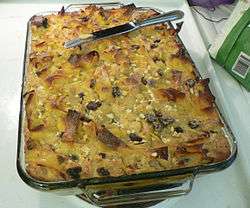Kugel
|
Noodle kugel | |
| Type | Pudding or casserole |
|---|---|
| Place of origin | Jewish from Central Europe. Today mostly in Israel and the United States. |
| Main ingredients | Egg noodles or potatoes |
|
| |
Kugel (קוגל kugl, pronounced IPA: [ˈkʊɡl̩]) is a baked pudding or casserole, most commonly made from egg noodles (Lokshen kugel) or potato. It is a traditional Ashkenazi Jewish dish, often served on Shabbat and Yom Tov.[1]
Etymology
The name of the dish comes from the Middle High German kugel meaning "sphere, globe, ball"; thus the Yiddish name likely originated as a reference to the round, puffed-up shape of the original dishes (compare to German Gugelhupf—a type of ring-shaped cake). Nowadays, however, kugels are often baked in square pans.
History
The first kugels were made from bread and flour and were savory rather than sweet. About 800 years ago, cooks in Germany replaced bread mixtures with noodles or farfel. Eventually eggs were incorporated. The addition of cottage cheese and milk created a custard-like consistency common in today's dessert dishes. In Poland, Jewish homemakers added raisins, cinnamon and sweet curd cheese to noodle kugel recipes. In the late 19th century, Jerusalemites combined caramelized sugar and black pepper in a noodle kugel known as "Yerushalmi kugel" or "Jerusalem kugel," which is a commonly served at Shabbat kiddushes and is a popular side dish served with cholent during Shabbat lunch.
In Romania, this dish is called Budinca de Macaroane/Paste Fainoase (Maccaroni/Pasta Pudding), and it is a traditional Romanian dish. In certain villages throughout the country it is known as "Baba Acolo". It is made with or without cheese, but it most always includes raisins.[2]
Savory kugel may be based on potatoes, matzah, cabbage, carrots, zucchini, spinach or cheese.[3]
A similar traditional Belarusian dish is potato babka.
In Lithuania, this dish is called Kugelis. It is baked potato pudding and it is a traditional Lithuanian dish. The main ingredients are potatoes, bacon, milk, onions, and eggs. It may be spiced with salt, black pepper, bay leaves, and/or marjoram. It is usually eaten with sour cream, or spirgai, a topping made with fried fatty bacon (usually belly bacon) and diced onions.[4]
Jewish festivals
Kugels are a mainstay of festive meals in Ashkenazi Jewish homes, particularly on the Jewish Sabbath and other Jewish holidays or at a Tish. Some Hasidic Jews believe that eating kugel on the Jewish Sabbath brings special spiritual blessings, particularly if that kugel was served on the table of a Hasidic Rebbe.[5]
While noodle kugel, potato kugel, and other variations are dishes served on Jewish holiday meals, matzo kugel is a common alternative served at Passover seders which is adjusted to meet passover kosher requirements.
South African slang usage
Among South African Jews, the word "kugel" was used by the elder generation as a term for a young Jewish woman who forsook traditional Jewish dress values in favor of those of the ostentatiously wealthy, becoming overly materialistic and over groomed, the kugel being a plain pudding garnished as a delicacy. The women thus described made light of the term and it has since become an amusing rather than derogatory slang term in South African English, referring to a materialistic young woman.[6]
See also
References
- ↑ In search of the holy kugel, Haaretz
- ↑ "Budinca de Macaroane".
- ↑ "Kugels". rec.food.cuisine.jewish Archives. Mimi's Cyber Kitchen. Retrieved July 2, 2013.
- ↑ von Bremzen, Anya; Welchman, John (1990). Please to the Table: The Russian Cookbook. New York: Workman Publishing. pp. 319–20. ISBN 0-89480-845-1.
- ↑ Allan Nadler, "Holy Kugel: The Sanctification of Ashkenzaic Ethnic Food in Hasidism", in Leonard Greenspoon, ed., Food & Judaism Creighton University Press, 2005), ISBN 978-1-881871-46-0, pp. 193–211.
- ↑ Sarah Britten (2006). The Art of the South African Insult. 30 degrees South Publishers. pp. 198–199. ISBN 978-1920143053. Retrieved July 2, 2013.
